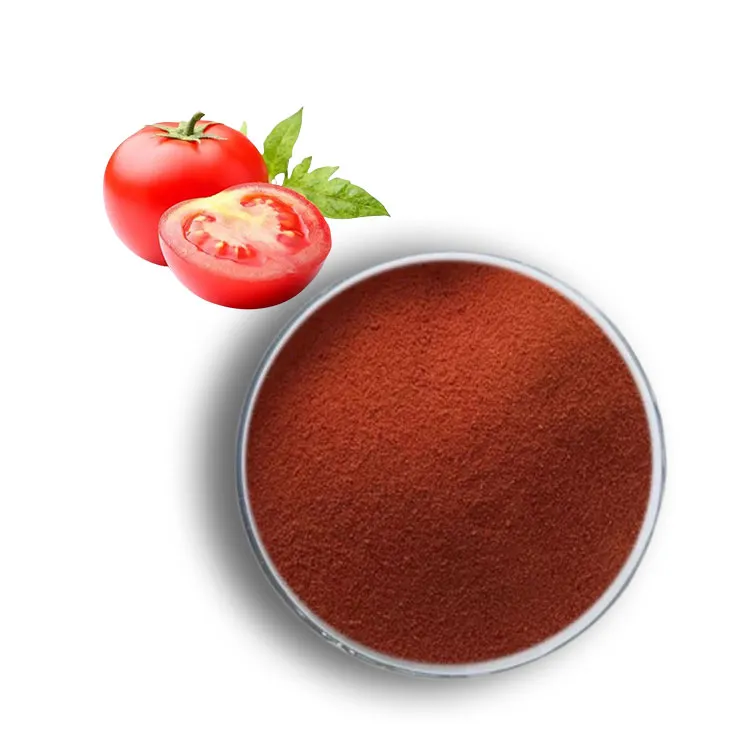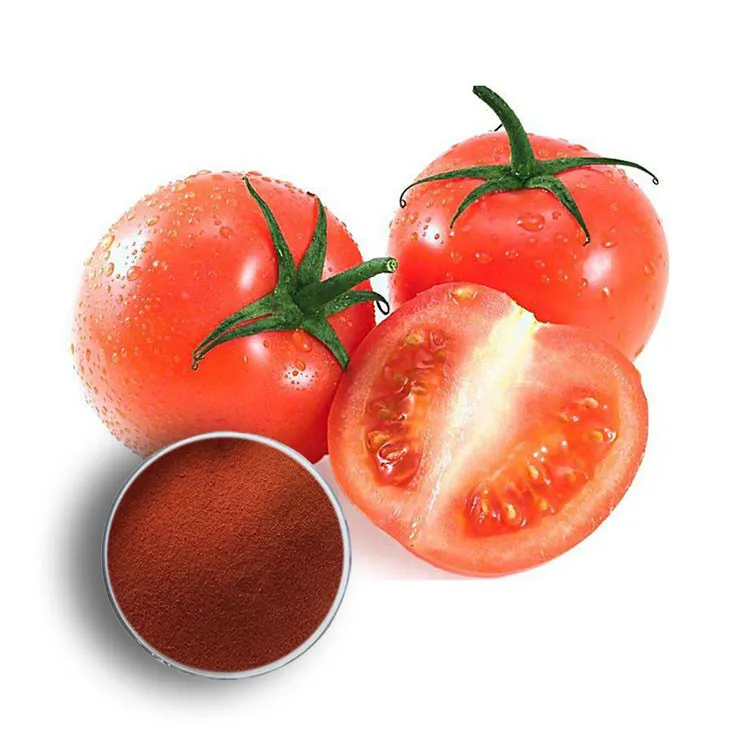- 0086-571-85302990
- sales@greenskybio.com
How to make powder with lycopene?
2024-11-27

1. Introduction to Lycopene
Lycopene is a bright red carotenoid pigment and phytochemical found in tomatoes and other red fruits and vegetables. It has powerful antioxidant properties, which can help protect cells from damage caused by free radicals. Due to its health - beneficial properties, Lycopene has attracted increasing attention in various industries, such as the food, pharmaceutical, and cosmetic industries. Lycopene powder is a convenient form for its application, as it can be easily incorporated into different products.

2. Raw Material Selection
2.1 Source of Lycopene
The main source of lycopene for powder production is tomatoes. Tomatoes are rich in lycopene, and different varieties of tomatoes may have different lycopene contents. For example, some special - bred high - lycopene tomato varieties are preferred. In addition to tomatoes, other fruits and vegetables like watermelons, pink grapefruits also contain lycopene, but they are less commonly used as the main source due to cost and availability.2.2 Quality of Raw Materials
When selecting tomatoes as the raw material, factors such as freshness, maturity, and absence of diseases and pests need to be considered. Fresh and fully - ripened tomatoes generally have a higher lycopene content. Tomatoes should be free from any chemical contaminants or residues from pesticides and fertilizers. Organic tomatoes are often a better choice as they are grown without synthetic pesticides and fertilizers, ensuring a purer source of lycopene.
3. Extraction of Lycopene
3.1 Solvent Extraction
One of the common methods for lycopene extraction is solvent extraction. Organic solvents such as hexane, acetone, or ethyl acetate can be used.- First, the tomatoes are crushed into a pulp. This can be done using a blender or a mechanical crusher.
- Then, the pulp is mixed with the selected solvent in a suitable ratio. For example, a ratio of 1: 3 (tomato pulp: solvent) may be used.
- The mixture is stirred thoroughly for a certain period, usually several hours, to ensure that the lycopene is dissolved in the solvent.
- After that, the mixture is filtered to separate the solid residue from the solvent - containing lycopene. The filtrate contains the dissolved lycopene.
3.2 Supercritical Fluid Extraction
Supercritical fluid extraction is a more advanced method. Carbon dioxide in its supercritical state is often used as the extraction medium.- The tomatoes are first prepared as in the solvent extraction method, i.e., crushed into a pulp.
- The supercritical CO₂ is passed through the tomato pulp under high pressure and specific temperature conditions. The supercritical CO₂ has properties similar to both a gas and a liquid, which allows it to effectively extract lycopene.
- By adjusting the pressure and temperature, the selectivity of the extraction can be controlled. When the extraction is complete, the pressure is released, and the CO₂ returns to its gaseous state, leaving behind the lycopene extract.

4. Purification of Lycopene Extract
4.1 Column Chromatography
Column chromatography is often used for purifying lycopene extract.- A chromatography column is filled with a suitable stationary phase, such as silica gel.
- The lycopene - containing extract is loaded onto the top of the column.
- An appropriate mobile phase, such as a mixture of solvents, is then passed through the column. Different components in the extract will move at different rates through the column based on their affinity to the stationary and mobile phases. Lycopene can be separated from other impurities.
- The purified lycopene fraction is then collected from the column.
4.2 Crystallization
Crystallization is another purification method.- The lycopene extract is concentrated by evaporating the solvent under reduced pressure.
- Then, the concentrated solution is cooled slowly. As the temperature decreases, lycopene starts to crystallize out of the solution.
- The crystals are then separated from the remaining liquid, which contains impurities. This can be done by filtration or centrifugation.
5. Conversion to Powder
5.1 Spray Drying
Spray drying is a widely used method for converting the purified lycopene into powder.- The purified lycopene solution is first prepared. This may involve dissolving the lycopene in a suitable carrier, such as maltodextrin or gelatin, to improve its stability during the drying process.
- The solution is then pumped into a spray dryer. In the spray dryer, the solution is atomized into small droplets through a nozzle.
- Hot air is then passed through the chamber containing the droplets. The hot air quickly dries the droplets, leaving behind lycopene powder. The temperature and flow rate of the hot air need to be carefully controlled to ensure proper drying without degrading the lycopene.
5.2 Freeze Drying
Freeze drying is another option for powder formation.- The lycopene solution is first frozen at a very low temperature, usually below - 40°C.
- The frozen sample is then placed in a freeze - dryer. In the freeze - dryer, the pressure is reduced, and the ice in the sample sublimates directly from the solid state to the gaseous state, leaving behind the lycopene in powder form.
6. Quality Control Measures
6.1 Purity Analysis
High - performance liquid chromatography (HPLC) is commonly used to analyze the purity of lycopene powder.- HPLC can separate and quantify the lycopene in the powder, and detect any impurities present. The purity of the lycopene powder should meet certain industry standards, usually above 90% for high - quality products.
6.2 Stability Testing
- Stability testing is carried out under different conditions such as temperature, light, and humidity. For example, the lycopene powder is stored at different temperatures (room temperature, 4°C, and - 20°C) for a certain period, and its degradation is monitored. A stable lycopene powder should show minimal degradation over time.
- Light stability is also important. Lycopene is sensitive to light, so the powder is exposed to different light intensities and wavelengths, and the changes in its properties are measured.
6.3 Microbiological Testing
- Microbiological tests are conducted to ensure that the lycopene powder is free from harmful microorganisms such as bacteria, fungi, and molds. Total plate count, yeast and mold count, and tests for specific pathogens are carried out according to standard microbiological methods.
7. Significance of Lycopene Powder in Different Industries
7.1 Food Industry
- Lycopene powder can be used as a natural food colorant. It can add a bright red color to various food products such as processed meats, dairy products, and confectionery. In addition to its color - adding function, it also provides antioxidant benefits to the food, helping to extend the shelf - life of the products.
- It can be added to functional foods and dietary supplements. Due to its health - promoting properties, it is an attractive ingredient for products targeting consumers interested in health and wellness.
7.2 Pharmaceutical Industry
- Lycopene has been studied for its potential in preventing and treating certain diseases. In the pharmaceutical industry, lycopene powder can be formulated into tablets, capsules, or softgels for oral administration. It may be used in combination with other drugs or active ingredients for the treatment of conditions such as prostate cancer, cardiovascular diseases, etc.
- It can also be used in topical pharmaceutical products. For example, in creams or ointments for skin health, as lycopene may have antioxidant and anti - inflammatory effects on the skin.
7.3 Cosmetic Industry
- Lycopene powder is used in cosmetics for its antioxidant and anti - aging properties. It can be incorporated into skin care products such as creams, lotions, and serums. Lycopene helps to protect the skin from oxidative stress, which is one of the main causes of skin aging.
- It can also be used in lipsticks and other makeup products as a natural colorant, providing a beautiful red hue while also offering skin - friendly benefits.
8. Conclusion
The production of lycopene powder involves multiple steps from raw material selection to final product formation. Each step requires careful consideration and control to ensure the quality of the powder. The significance of lycopene powder in various industries makes it a valuable product. With continuous research and development, the production techniques are likely to be further improved, and the applications of lycopene powder are expected to expand in the future.
FAQ:
Q1: What are the main raw materials for making lycopene powder?
Typically, the main raw material for making lycopene powder is lycopene itself, which can be obtained from natural sources such as tomatoes. In some cases, synthetic lycopene may also be used as a raw material depending on the specific production requirements and cost - effectiveness.
Q2: What are the common techniques in making lycopene powder?
One common technique is spray drying. In this process, a lycopene - containing solution is sprayed into a hot air stream, which causes the water to evaporate quickly, leaving behind the lycopene powder. Another technique is freeze - drying, where the lycopene - containing material is frozen and then the water is removed under vacuum conditions. These techniques help in preserving the properties of lycopene while converting it into a powder form.
Q3: How important is quality control in the production of lycopene powder?
Quality control is extremely important in the production of lycopene powder. It ensures that the final product meets certain purity standards. This includes testing for the presence of contaminants, accurate measurement of the lycopene content, and ensuring proper particle size distribution. Quality control also helps in maintaining the stability and bioavailability of the lycopene powder, which are crucial factors for its applications in various industries.
Q4: What are the applications of lycopene powder in different industries?
In the food industry, lycopene powder is often used as a natural colorant and a functional ingredient due to its antioxidant properties. In the pharmaceutical and nutraceutical industries, it is used in supplements for potential health benefits such as reducing the risk of certain diseases. In the cosmetic industry, it can be added to skincare products for its antioxidant and anti - aging properties.
Q5: How can the stability of lycopene powder be ensured during production?
To ensure the stability of lycopene powder during production, several measures can be taken. Firstly, protecting it from exposure to light, heat, and oxygen is crucial as lycopene is sensitive to these factors. Using proper packaging materials, such as opaque and air - tight containers, can help. Secondly, adding appropriate stabilizers during the production process can enhance its stability. Also, maintaining proper storage conditions, like low - temperature and low - humidity environments, is beneficial for the long - term stability of lycopene powder.
Related literature
- Title: Production and Applications of Lycopene Powder: A Review"
- Title: "Advanced Techniques in Lycopene Powder Manufacturing"
- Title: "Quality Assurance in Lycopene Powder Production: Best Practices"
- ▶ Hesperidin
- ▶ citrus bioflavonoids
- ▶ plant extract
- ▶ lycopene
- ▶ Diosmin
- ▶ Grape seed extract
- ▶ Sea buckthorn Juice Powder
- ▶ Beetroot powder
- ▶ Hops Extract
- ▶ Artichoke Extract
- ▶ Reishi mushroom extract
- ▶ Astaxanthin
- ▶ Green Tea Extract
- ▶ Curcumin Extract
- ▶ Horse Chestnut Extract
- ▶ Other Problems
- ▶ Boswellia Serrata Extract
- ▶ Resveratrol Extract
- ▶ Marigold Extract
- ▶ Grape Leaf Extract
- ▶ blog3
- ▶ blog4
-
D - Mannose Manufacturer
2024-11-27
-
The best organic chia seed powder.
2024-11-27
-
The extraction process of Maca extract.
2024-11-27
-
Organic Motherwort Extract Powder Supplier.
2024-11-27
-
The Pure Vitamin K2 Most Worth Buying.
2024-11-27
-
Elderberry Extract
2024-11-27
-
White Willow Bark Extract
2024-11-27
-
Calendula Extract
2024-11-27
-
Honeysuckle Pollen
2024-11-27
-
Cactus Extract
2024-11-27
-
Black Pepper Extract
2024-11-27
-
Peppermint Extract Powder
2024-11-27
-
Bayberry Extract
2024-11-27
-
Citrus bioflavonoids
2024-11-27
-
Senna Leaf Extract
2024-11-27





















